In the aftermath of a black metal murder in the local music scene, Jim Algie looks back at the merger of Satanism and rock that ended up on a collision course in the Thai capital.
Ever since rock ‘n’ roll was dubbed the “devil’s music” by some American puritan, and piles of Elvis Presley records set ablaze by outraged citizens back in the 1950s as if they were heretics at the Salem Witch Trials of 1688, rockers have dabbled in diabolism, unwittingly or not.
What better way to offend the conservatives and fundamentalists than by allying yourself with Satan? Still, back in 1976, it did seem daring when Johnny Rotten called himself the “antichrist” in the first line of the first Sex Pistols’ single, “Anarchy in the UK.” Far less so when shock-rocker Marilyn Manson called one of his albums from the ’90s Antichrist Superstar.
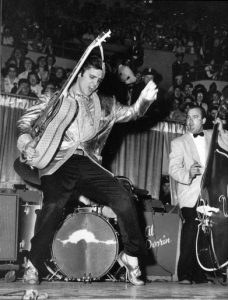
Elvis’s influence on rock and even black metal is incalculable
That was a lot farther than Elvis was ever allowed to go. Given the strict sexual mores of the 1950s, with the engines of the economy fuelled by the factories and the fallout of World War II, “Elvis the Pelvis” could only be shot from the waist up on the Ed Sullivan TV show. His suggestive moves were too erotic for mainstream audiences. The demon, in this case, was sex before or outside of marriage.
On the same program, even some five years later, the Rolling Stones had to change the word “night” for “time” in the chorus of their hit “Let’s Spend the Night Together” for fear it would it would lead to lewd behavior among their teenage audiences.
(Now that “twerking” has become an official word in the Oxford Dictionary and the likes of Miley Cyrus and Rihanna try to simulate sex on stage, those scandals look like tepid examples from an altogether tamer era.)
MICK LUCIFER
As a reaction to this conservatism, the “Swinging ‘60s,” platform booted and mini-skirted, came sashaying along with Mick Jagger as the era’s self-proclaimed Lucifer. As great of a song as “Sympathy for the Devil” is – Jean Luc Goddard concocted a whole movie around the group writing and recording it – the Stones were masters of contriving their own controversies to stay in the headlines and the charts.
So was Led Zeppelin. Many thought that Jimmy Page’s purchasing of the house once owned by occultist Aleister Crowley at Loch Ness was little more than a publicity stunt. That was not the case. Page was fascinated by this adept in the black arts of Satanism and sex magic.
“There were two or three owners before Crowley moved into it,” Page told Rolling Stone in 1975. “It was also a church that was burned to the ground with the congregation in it. Strange things have happened in that house that had nothing to do with Crowley. The bad vibes were already there. A man was beheaded there, and sometimes you can hear his head rolling down.”
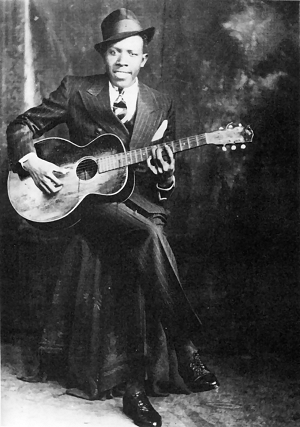
One of only two images of Robert Johnson known to exist
BLACK DEVILS
Like so many other aspects of rock, the macho swagger and juvenile misogyny set to 4/4 rhythms and jagged guitar riffs, the devilry also dates back to the Mississippi Delta bluesmen like Robert Johnson. The cornerstone of all rock legends is the tale of Robert Johnson going down to the crossroads to sell his soul to the devil in exchange for musical talent.
(This was a white misunderstanding of a black superstition. Whenever someone went away for a while and came back with a new skill, as Johnson did with his music, the blacks of the American south said that he’d picked up the skill from the devil.)
Only a few years after developing his astonishing prowess on guitar and vocals, having left behind only a handful of recorded originals and three verified photographs, Johnson passed away under mysterious circumstances, just before a gig, in 1938. (That makes him the first member of the “27 Club” that later included Jimi Hendrix, Janis Joplin, Jim Morrison, Kurt Cobain and Amy Winehouse).
Shortly before he died, the singer and guitarist was seen crawling around on all fours, howling like a werewolf – proof that he was demoniacally possessed, some said. The more sober version of events insists his moonshine was poisoned by the jealous husband of a woman he was having an affair with.
Johnson, whose songs have been covered by the Stones, Eric Clapton, and most memorably by the Gun Club (“Preaching the Blues”), was his own greatest mythmaker, writing tracks like “Hellhound On My Trail” and “Me and the Devil Blues.” In the latter song, Johnson not only recounts his encounters with the prince of darkness, but spits in the face of his white Christian oppressors by insisting that “you can bury my body down by the highway side,” which was the traditional resting place for suicides and heretics who were not allowed to be buried in hallowed ground, “so my old evil spirit can catch a Greyhound bus and ride.”
There is a sarcastic sense of humor at work in the last verse, but not in an earlier part when Johnson moans, “Me and the devil was walking side by side/I’m gonna beat my woman till I get satisfied.”
What the singer intended as a cautionary tune, equating the wife-beater with Lucifer, was lost on the hordes of heavy metal musicians who cranked up his riffs and lyrics to 13 in the ’70, ‘80s, and even now.
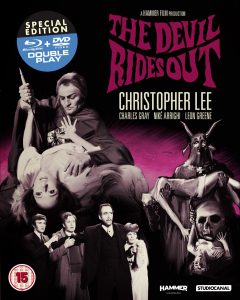
Horror movies were a key influence on Black Sabbath and black metal
SABBATH BLOODY SABBATH
Black Sabbath began as a fairly generic, if extremely loud, blues band from Birmingham, England named Earth. Their practice space overlooked a theatre showing horror films produced by the infamous Hammer Film Studios, like The Devil Rides Out and Blood from the Mummy’s Tomb. When the group fronted by Ozzy Osbourne saw how popular the films were compared to how little known their band was, they changed their name to Black Sabbath. Then the bassist/lyricist Geezer Butler began giving occult overtones to songs like “War Pigs.”
The ‘70s were full of all sorts of allegations of Satanism, like bands supposedly putting backwards messages on their albums in tribute to the devil, as Satanists would blaspheme the Bible by reading it backwards or holding crosses upside down.
(We were not even devil worshippers, just Sabbath and Zep fans. But when we’d run out of rolling papers sometimes, as a friend said, while pilfering the good book for a new leaf, “Luke 13, Repent or Perish, smokes pretty good.”)
BLACK METAL MURDER AND MAYHEM IN NORWAY
The ‘80s was a blast furnace for forging new strains and mutations of heavy metal, with speed metal riffing on punk’s energy, death metal harkening back to Sabbath, and black metal somewhere in between, with plenty of leather, studs and spikes, KISS and Alice Cooper-like theatrics, and the kind of baritone, growling vocals that sounded like either Lucifer had a stranglehold on the singer’s vocal cords or the singer had a case of the dry heaves.
The most notorious black metal group of all time is Mayhem. These blackhearts shocked everyone with behaviour that made the usual rock-musician antics pale by comparison. One of their first singers, nicknamed “Dead,” who performed wearing “corpse paint” and carried around a dead crow in a plastic bag on one tour because he liked doing live shows with the stench of death in his nostrils, slashed his wrists and throat before shooting himself in the head in 1991. Part of the singer’s suicide note read: “Sorry about all the blood. Let the party begin.”
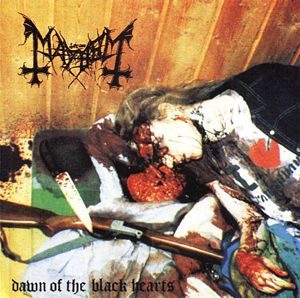
The infamous bootleg cover for black metal pioneers Mayhem showing Dead’s suicide scene.
The guitarist, Euronymous, found the body and ran out to buy a disposable camera to shoot photos of the corpse. One of them turned up on the cover of a Mayhem bootleg called Dawn of the Black Hearts. He also made necklaces out of bone fragments from Dead’s skull.
Not long after the suicide, Mayhem’s former bassist, Count Grishnackh, stabbed the guitarist to death. The Count, real name Varg Vikernes, took his pseudonym from a wicked Orc in the Lord of the Rings. He was sentenced to 21 years in jail for the killing and multiple arson attacks on historic churches in Norway, many of which were razed to the ground. When the judge read out his sentence, Vikernes grinned.
Out of hell’s kitchen and into Hitler’s bunker, he dabbled with neo-Nazism for a while in prison before declaring himself a pagan of Norse descent. The church burnings he said were to pay back the Christian church for the atrocities they had foisted upon the Vikings.
Vikernes was released from prison in 2009 after serving 15 years in jail. He now resides in France with his wife and kids and still makes music with his band Burzum (another Lord of the Ringsreference), which has been named as an infernal influence by more young arsonists implicated in church burnings across Europe, Australia and Canada.
SCREAMING BLACK MURDER IN BANGKOK
Since the Norwegian band Gorgoroth released Black Mass Krakow in 2008, featuring live clips of them on-stage with real sheep heads impaled on stakes, and nude models who appeared to be crucified, the biggest sensation to rock the world of metal took place on January 9 in Bangkok, when the singer and guitarist of the Thai black metal act, Surrender of Divinity, was found stabbed to death by a Satan-worshipping fan.
Samong “Avaejee” Traisattha was 36. The group formed in 1996. They recorded a number of albums like Oriental Hell Rhythmics and Manifest Blasphemy: The Abortion of the Immaculate Conception which had earned the group an international following in the metal underground.
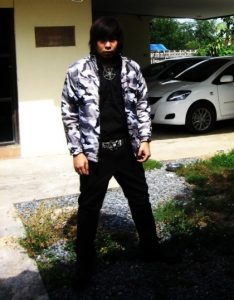
The man who killed the bassist from Surrender of Divinity, Thailand’s premier black metal outfit
The musician’s wife claimed that the killer is Prakarn “Sant” Harnphanbusakorn, a fan of his group who had come over to have a drink with him. Police believe that this is the same man who uses Facebook under the name Maleficent Meditation. In a bizarre series of rants on the social media website he took credit for the killing, claiming that he stabbed the musician 30 times while he begged for mercy.
“I have intended to end my life since I was 25. Because I’ll die eventually, I want to drag down with me those who tarnish Satanism. I got a message from Satan, who agreed with me. I could contact Satan who agreed with me. I could contact Satan as I practice meditation every day,” he wrote.
“If I did not kill him, I’m sure he would be murdered by someone else later. I initially wanted to kill 20-30 people, but the situation was not possible. Police set up many road checkpoints,” the Facebook message said.
For more than five weeks the killer was on the loose and on the run. He eventually turned himself in on February 19. At the press conference he claimed that he killed the musician in self-defense, to which Avaejee’s wife, and the mother of his two sons, yelled, “Liar!” He also claimed that he did not post anything on Facebook after the murder.
While police were searching for him, they visited his parent’s house where he lived. They told them that he drives a Toyota and studies law at Ramkhamhaeng University. He supports them, according to a Bangkok Post story, with his stock market investments.
(A lawyer, stockbroker, Satanist and killer? It sounds like a Bangkok sequel to Bret Easton Ellis’s American Psycho.)
The news of the murder has caused an outbreak of comments on Facebook, most of them railing against the murderer and hoping the musician’s death is avenged (“May the murderer be tortured to death with hateful force when he is found, then his wretched body fed to the dogs,” goes a typical comment.)

Crime scene photo showing the black metal musician’s body
Leighton Misticus called the killer a poser: “The people who are acting like this is ok are the posers… Blackmetal is and will always be an Occult art, not a path of mundane activity, killing for no reason, this reveals all posers who are obsessed with shock rock and the images of an idiot.”
Others weighed in with comments about the outrage over crime scene photos being posted, like Alesha Akkison: “Are you all REALLY that upset?! this is BLACK FUCKING METAL! it will only be a shame if this photo doesn’t become an album cover!!”
But the rest of his band, Surrender of Divinity, posted a photo of him blowing flames on stage and this message: “AVAEJEE, our Black Vomitor/Bass Thunder and most importantly our blood-brother has passed away yesterday by a cruel murdered.
No words can express about this lost in our horde.
Have a rest down there brother!
May our blackest flames blazing bright forever!
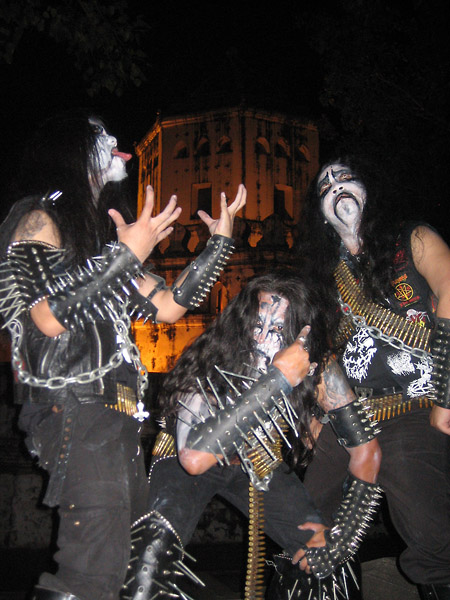
Surrender of Divinity was Thailand’s longest-running black metal act
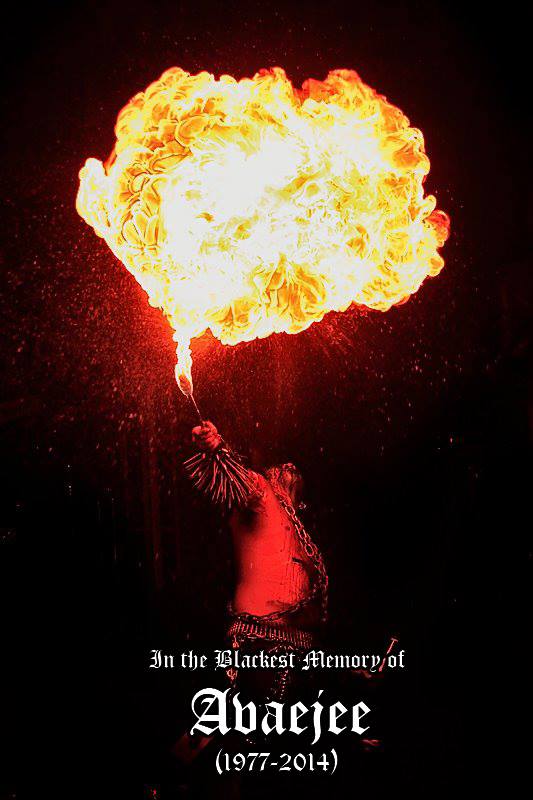
Tribute to the late black metal singer and bassist
This story has been updated with full details about the killer’s prosecution and jail term in Jim Algie’s new book, On the Night Joey Ramone Died: Tales of Rock and Punk from Bangkok, New York, Cambodia and Norway, which is available as an ebook and paperback from Amazon. One of the tales documents the rise of black metal in Norway, with the murders, suicides and church burnings, and also contains many shout outs to Mayhem and Cannibal Corpse, whose logo is featured on the back cover below.
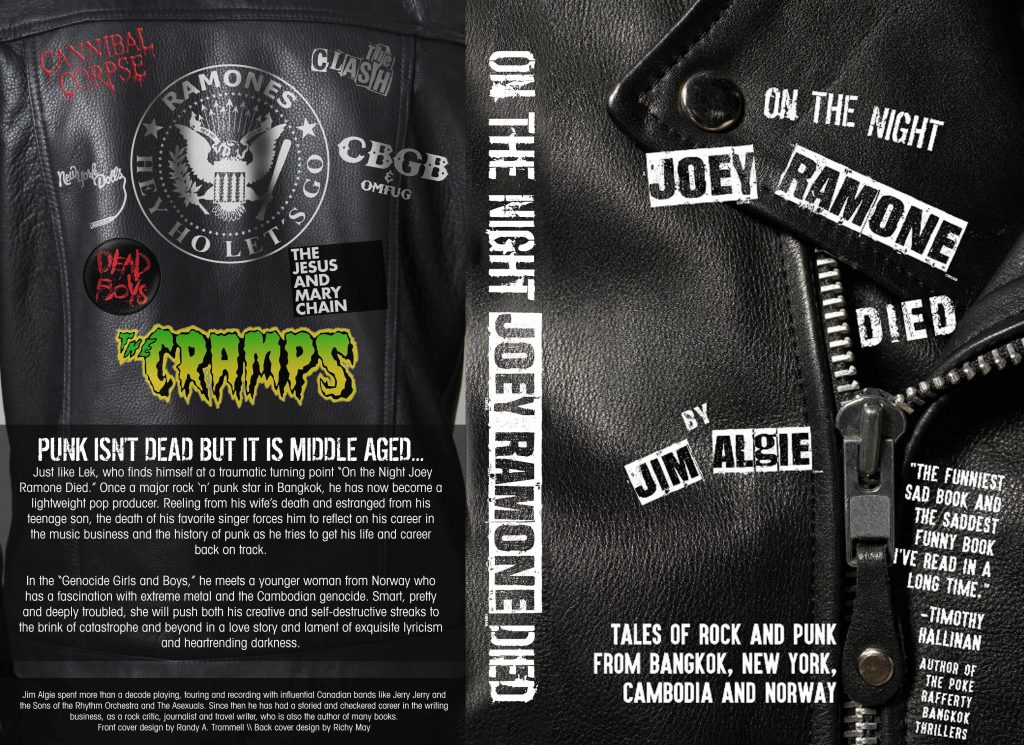
New paperback cover of On the Night Joey Ramone Died


Recent Comments